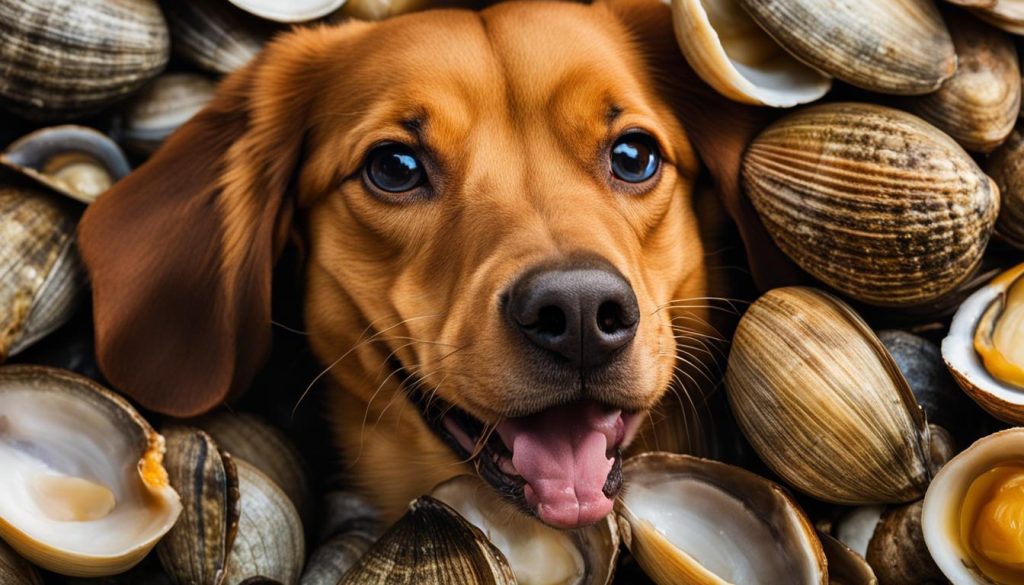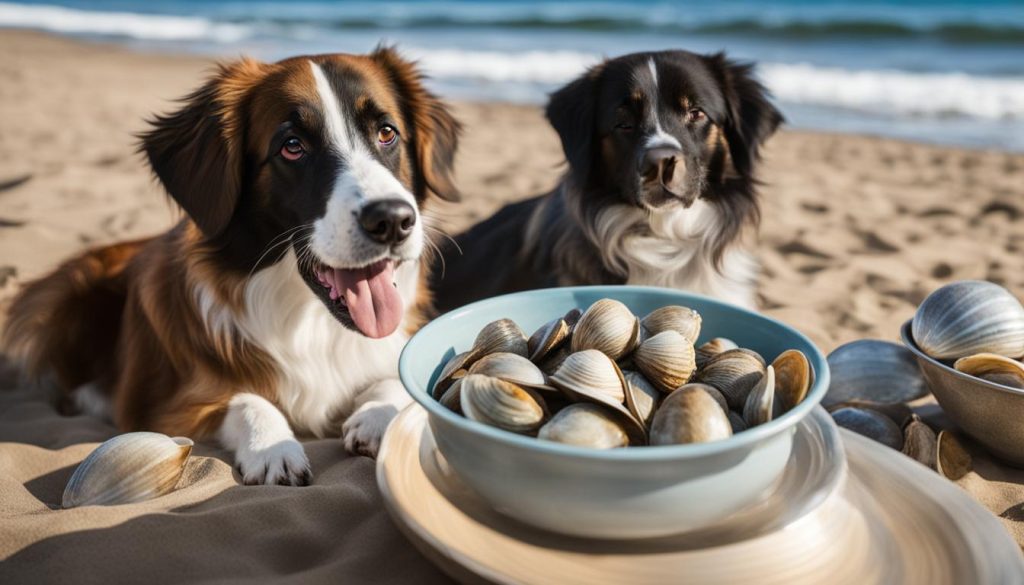As an ardent dog lover, I often explore the various dietary options that could enrich my furry friend’s meals. Naturally, the question arises – can dogs eat clams? With an interest in safe seafood for dogs and expanding their palate beyond the usual kibble, uncovering the facts about dog-friendly seafood is crucial. It’s worth noting that the relationship between our canine companions and seafood is not black and white. While incorporating canine diet and clams might seem like uncharted territory, there’s a trove of information that can guide responsible pet owners.
Before spooning out servings of clam chowder for our pups, it’s important to dive deep into the do’s and don’ts, ensuring their safety and health aren’t compromised. So, let’s shell out the details!
Can Dogs Eat Clams? The simple answer is yes, they can.
- Clams can be a nutritious addition to a dog’s diet but should be offered in moderation.
- Cooked clams are safer for dogs as raw shellfish may contain harmful bacteria and parasites.
- Always consult with a veterinarian before including new seafood in your dog’s diet.
- Be watchful for potential allergic reactions when your dog tries clams for the first time.
- Consider the source of your clams to minimize the risk of shellfish poisoning and exposure to toxins.
- Avoid feeding dogs clam shells which could pose a choking hazard or cause digestive issues.
- Understanding your dog’s unique dietary needs is pivotal when thinking about diversifying their menu with clams.
Introduction to Clams in Your Dog’s Diet
As a devoted pet parent, I constantly explore new foods that could enhance my dog’s health and happiness. That’s why I found myself pondering the potential of introducing clams in a dog’s diet. These bivalve mollusks are found in various habitats and are well-known for their delicate taste and nutritional value among humans. But when it comes to our canine companions, understanding the nutritional benefits of clams for dogs is essential before incorporating them into their meals.
One key element to remember is that clams should always be presented as cooked clams for dogs. The risk of bacteria and parasites in raw shellfish is a concern that cannot be overlooked. Furthermore, clams, although nutritious, are not common in many pet diets, which means we should proceed with caution.
By consulting with a veterinarian, you can tailor this intriguing seafood option to fit safely into your dog’s diet. Ensuring this aligns with their individual health requirements is tantamount. With the right preparation and serving size, clams can be a healthy treat that supports a well-rounded diet.

Can Dogs Eat Clams: Understanding the Risks and Benefits
As a pet owner, I always want to ensure the treats I give my furry friend are both enjoyable and safe. While clams can serve as occasional treats for dogs, it’s critical to recognize the health risks of feeding clams to dogs, as well as the potential benefits. Proper knowledge and preparation are key to including this seafood in a canine’s diet.
Identifying Potential Allergies
When I introduced clams into my dog’s diet, I watched for signs of shellfish allergies, which, while rare, can have serious implications. It’s vital for dog owners to be vigilant and monitor their pets closely for any adverse reactions, such as itching, swelling, or digestive upset, which could indicate a possible allergy to clams.
Nutritional Profile of Clams
Clams have a rich nutritional profile that can offer a variety of benefits when included in a dog’s diet. They are a good source of minerals and proteins, which can contribute positively to my dog’s overall health. However, understanding the appropriate serving size is crucial to avoid any nutrient imbalances.
Importance of Moderation and Preparation
I’ve learned that moderation is imperative when it comes to feeding clams to my dog. An occasional clam treat can be enjoyable, but too much can lead to health issues. Additionally, proper preparation, such as cooking the clams thoroughly, ensures that my pup enjoys his treat without the risk of bacterial or parasitic infections.
Essential Nutrients: How Clams Can Benefit Your Dog
As a dedicated dog owner, I’m always exploring new ways to enrich my furry friend’s diet with nutritious options. After careful research and consulting with my vet, I’ve discovered that the nutritional benefits of clams for dogs are quite compelling. These little shellfish pack a punch with substantial amounts of essential amino acids, which are the building blocks of protein. Protein is vital for muscle health and overall well-being, making clams a valuable treat for dogs.
Aside from protein, clams are also brimming with vitamin B12 and iron. Vitamin B12 is crucial for maintaining proper brain function and aiding in neurological health, while iron aids in oxygen transportation—a must for energetic pups. Dogs and clams might seem like an unusual pair, but when clams are prepared safely, they can be a dog-friendly seafood choice that offers both taste and nutrition.
I’ve noticed leaner proteins like clams can be especially beneficial for my dog, providing all the necessary nutrition without the excess calories. Moreover, clams harbour omega-3 fatty acids, known for their anti-inflammatory properties, which are excellent for my dog’s joint health and may even help improve skin conditions. Indeed, integrating clams into my dog’s diet has been a game-changer, offering a host of nutrients that support a happy, healthy life.

Beyond these, clams contain one of the few animal-based sources of vitamin C, supporting the formation of collagen, immune health, and tissue repair—a surprising benefit I hadn’t initially considered. While my dog can produce vitamin C naturally, the extra boost from clams can offer additional support for his immune system and overall health.
It’s important to remember that while the essential amino acids in clams can be excellent for a dog’s diet, any introduction of new foods should be done gradually and with attentive monitoring for any adverse reactions. Always seek professional guidance from your veterinarian when you’re adding something like clams to ensure it complements your dog’s specific dietary needs. Being cautious and informed allows me to ensure that my dog gets only the best from his seafood experiences.
When Clams Can Cause Harm: Health Concerns for Canines
As a pet owner, I’m always cautious about introducing new foods into my dog’s diet, especially ones that come from the sea like clams. While they can be a tasty treat, they might also pose significant health risks, such as symptoms of shellfish poisoning in dogs, which every pet parent should be aware of. When we look at the potential hazards of clam shells to dogs or the presence of heavy metals in seafood, it becomes clear that extra care is necessary to prevent our canine friends from adverse health effects.
Recognizing Symptoms of Shellfish Poisoning
It’s vital for me to recognize the signs of shellfish poisoning since it can lead to serious health concerns. If my dog ingests contaminated clams, the consequences can range from mild to severe. The symptoms to look for include vomiting, diarrhea, and in more serious cases, neurological issues like disorientation, seizures, or difficulty in coordination. Being vigilant and spotting these early signs can make all the difference in ensuring my dog’s safety and well-being.
Heavy Metals and Other Toxins in Seafood
Another concern that I keep in mind is the presence of heavy metals and toxins in seafood. The risk of feeding clams to dogs isn’t just limited to shellfish poisoning; there’s also the potential of heavy metals accumulating in their bodies over time. This is a significant issue because these contaminants can damage the nervous system, kidneys, and other vital organs. Hence, sourcing clams from trusted and uncontaminated areas is an absolute must for me.
The Danger of Clam Shells
Lastly, the hazards of clam shells to dogs shouldn’t be overlooked. These hard fragments can be a choking hazard or cause gastrointestinal blockage. Even if they swallow the shells without an immediate problem, they can still cause lacerations in their digestive tract. As a rule of thumb, I always ensure that any clams I give to my dog are cleaned and shell-free to prevent such risks.
When Clams Can Cause Harm: Health Concerns for Canines
Can dogs eat clams safely?
Yes, dogs can safely eat clams if they are cooked properly and given in moderation. However, it’s essential to introduce clams carefully into your dog’s diet and consult with your veterinarian first, as dogs can have individual sensitivities or allergies.
Are there any benefits to feeding my dog clams?
Clams can be a nutritious addition to a dog’s diet. They are rich in essential nutrients like vitamin B12, iron, lean protein, amino acids, vitamin C, and omega-3 fatty acids, which can offer various health benefits including supporting muscle health and brain function.
Can clams be considered dog-friendly seafood?
Yes, clams can be considered dog-friendly seafood when they are cooked without any harmful additives, like garlic or onion, and served in moderation. They should be an occasional treat rather than a staple in your dog’s diet.
What is the importance of moderation when feeding clams to dogs?
Feeding clams in moderation is crucial because too much seafood can introduce excessive amounts of certain nutrients, heavy metals, or toxins into your dog’s diet. Always adhere to recommended portions and maintain a balanced diet.
What are the health risks of feeding clams to dogs?
The health risks associated with feeding clams to dogs include the potential for shellfish allergies, the risk of gastrointestinal upset or shellfish poisoning, and the ingestion of harmful toxins or heavy metals. Monitor your dog carefully when introducing clams and ensure they are from a reputable source.
How should clams be prepared for dogs?
Clams should be thoroughly cooked to eliminate harmful bacteria and parasites. They should be served plain, without any added seasonings or sauces that could be harmful to dogs.
Recognizing Symptoms of Shellfish Poisoning
Symptoms of shellfish poisoning in dogs include vomiting, diarrhea, lack of coordination, and in severe cases, neurological symptoms. If you notice any of these symptoms after your dog eats clams, seek veterinary care immediately.
Heavy Metals and Other Toxins in Seafood
Seafood, including clams, can contain heavy metals such as mercury, as well as other toxins which can be harmful if ingested in large amounts. It’s vital to source clams from clean, uncontaminated waters and serve them as an occasional treat.
The Danger of Clam Shells
Clam shells pose a choking hazard and can cause intestinal blockages or damage your dog’s mouth and digestive tract. Always remove shells before offering clams to your dog.






